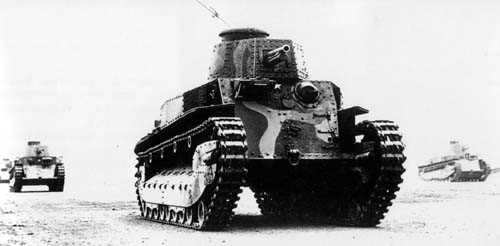
| Year | 1936 |
| Vehicle Type | Medium Tank |
| Origin & Designer | Japan/Mitsubishi |
| Numbers Produced | 126 |
| Crew | 4 (Commander/Gunner, Loader, Hull Gunner & Driver) |
| Main Armament | 1 x Type 90 57mm L/14.4 Gun |
| Main Armament | [@sponson_traverse] |
| Elevation | -8° to +25° |
| Turret Traverse | 360° (Manual) |
| Gun Traverse | [@gun_traverse] |
| Gun Mount | [@gun_mounts] |
| Maximum Range | [@maximum_range] |
| Armour Penetration | [@armour_penetration] |
| Gun Sight | Telescopic |
| Secondary Armament | 2 x Type 91 6.5mm Machine Guns (Bow & Rear Turret) |
| Smoke Discharger | [@smoke_discharger] |
| Ammunition Carried | 100 x 57mm & 2.750 x 6.5mm |
| Height | 2.59m |
| Width | 2.16m |
| Length | 7.01m |
| Combat Weight | 12.791 kg |
| Ground Clearance | 0.48m |
| Fording Depth | 1.0m |
| Trench Crossing | 2.61m |
| Obstacle Clearance | 0.84m |
| Climbing Ability | 34° |
| Radio | Type 94 Mk. 4 |
| Armour | Hull Front: 17mm Hull Sides: 17mm Hull Rear: 17mm Hull Top: 10mm Hull Bottom: 6mm Gun Mantle: 10mm Turret Front: 15mm Turret Sides: 15mm Turret Rear: 15mm Turret Top: 10mm |
| Engine | Mitsubishi A6 120 VD (Petrol) |
| Transmission | 6 Forward & 1 Reverse |
| Maximum Road Range | 170 km |
| Maximum Cross Country Range | [@maximum_cross_country_range] |
| Maximum Water Range | [@maximum_water_range] |
| Maximum Road Speed | 25 kph |
| Maximum Cross Country Speed | 18 kph |
| Maximum Water Speed | [@maximum_water_speed] |
| Variants | [@variants] |
| Notes | The main difference between the 89A and 89B was the engine, with the 89B fitted with a diesel engine. This gave the 89B the honour of being the first diesel engined battle tank to be built in large numbers. Both models saw extensive action during the early phase of the war, but due to their slow speed and the availability of the more modern tanks like the Ha-Go and Chi-Ha, they were used in secondary theatres and roles. |